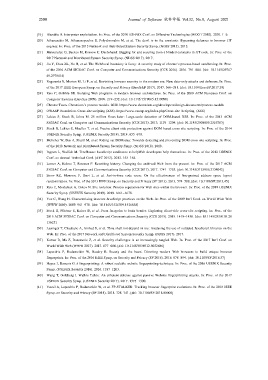Page 218 - 《软件学报》2021年第8期
P. 218
2500 Journal of Software 软件学报 Vol.32, No.8, August 2021
[19] Blazakis D. Interpreter exploitation. In: Proc. of the 2010 USENIX Conf. on Offensive Technologies (WOOT 2010). 2010. 1−9.
[20] Athanasakis M, Athanasopoulos E, Polychronakis M, et al. The devil is in the constants: Bypassing defenses in browser JIT
engines. In: Proc. of the 2015 Network and Distributed System Security Symp. (NDSS 2015). 2015.
[21] Maisuradze G, Backes M, Rossow C. Dachshund: Digging for and securing (non-) blinded constants in JIT code. In: Proc. of the
2017 Network and Distributed System Security Symp. (NDSS 2017). 2017.
[22] Jia Y, Chua ZL, Hu H, et al. The Web/local boundary is fuzzy: A security study of chrome’s process-based sandboxing. In: Proc.
of the 2016 ACM SIGSAC Conf. on Computer and Communications Security (CCS 2016). 2016. 791−804. [doi: 10.1145/29767
49.2978414]
[23] Rogowski R, Morton M, Li F, et al. Revisiting browser security in the modern era: New data-only attacks and defenses. In: Proc.
of the 2017 IEEE European Symp. on Security and Privacy (EuroS&P 2017). 2017. 366−381. [doi: 10.1109/EuroSP.2017.39]
[24] Reis C, Gribble SD. Isolating Web programs in modern browser architectures. In: Proc. of the 2009 ACM European Conf. on
Computer Systems (EuroSys 2009). 2009. 219−232. [doi: 10.1145/1519065.1519090]
[25] Chrome Team. Chromium’s process models. 2020. https://www.chromium.org/developers/design-documents/process-models
[26] OWASP Foundation. Cross-site scripting (XSS). https://www.owasp.org/index.php/Cross-site_Scripting_(XSS)
[27] Lekies S, Stock B, Johns M. 25 million flows later: Large-scale detection of DOM-based XSS. In: Proc. of the 2013 ACM
SIGSAC Conf. on Computer and Communications Security (CCS 2013). 2013. 1193−1204. [doi: 10.1145/2508859.2516703]
[28] Stock B, Lekies S, Mueller T, et al. Precise client-side protection against DOM-based cross-site scripting. In: Proc. of the 2014
USENIX Security Symp. (USENIX Security 2014). 2014. 655−670.
[29] Melicher W, Das A, Sharif M, et al. Riding out DOMsday: Towards detecting and preventing DOM cross-site scripting. In: Proc.
of the 2018 Network and Distributed System Security Symp. (NDSS 2018). 2018.
[30] Ingram L, Walfish M. TreeHouse: JavaScript sandboxes to helpWeb developers help themselves. In: Proc. of the 2012 USENIX
Conf. on Annual Technical Conf. (ATC 2012). 2012. 153−164.
[31] Lerner A, Kohno T, Roesner F. Rewriting history: Changing the archived Web from the present. In: Proc. of the 2017 ACM
SIGSAC Conf. on Computer and Communications Security (CCS 2017). 2017. 1741−1755. [doi: 10.1145/3133956.3134042]
[32] Snow KZ, Monrose F, Davi L, et al. Just-in-time code reuse: On the effectiveness of fine-grained address space layout
randomization. In: Proc. of the 2013 IEEE Symp. on Security and Privacy (SP 2013). 2013. 574−588. [doi: 10.1109/SP.2013.45]
[33] Reis C, Moshchuk A, Oskov N. Site isolation: Process separation for Web sites within the browser. In: Proc. of the 2019 USENIX
Security Symp. (USENIX Security 2019). 2019. 1661−1678.
[34] Yue C, Wang H. Characterizing insecure JavaScript practices on the Web. In: Proc. of the 2009 Int’l Conf. on World Wide Web
(WWW 2009). 2009. 961−970. [doi: 10.1145/1526709.1526838]
[35] Stock B, Pfistner S, Kaiser B, et al. From facepalm to brain bender: Exploring client-side cross-site scripting. In: Proc. of the
2015 ACM SIGSAC Conf. on Computer and Communications Security (CCS 2015). 2015. 1419−1430. [doi: 10.1145/2810103.28
13625]
[36] Lauinger T, Chaabane A, Arshad S, et al. Thou shalt not depend on me: Analysing the use of outdated JavaScript libraries on the
Web. In: Proc. of the 2017 Network and Distributed System Security Symp. (NDSS 2017). 2017.
[37] Kumar D, Ma Z, Durumeric Z, et al. Security challenges in an increasingly tangled Web. In: Proc. of the 2017 Int’l Conf. on
World Wide Web (WWW 2017). 2017. 677−684. [doi: 10.1145/3038912.3052686]
[38] Laperdrix P, Rudametkin W, Baudry B. Beauty and the beast: Diverting modern Web browsers to build unique browser
fingerprints. In: Proc. of the 2016 IEEE Symp. on Security and Privacy (SP 2016). 2016. 878−894. [doi: 10.1109/SP.2016.57]
[39] Hayes J, Danezis G. k-fingerprinting: A robust scalable website fingerprinting technique. In: Proc. of the 2016 USENIX Security
Symp. (USENIX Security 2016). 2016. 1187−1203.
[40] Wang T, Goldberg I. Walkie-Talkie: An efficient defense against passive Website fingerprinting attacks. In: Proc. of the 2017
USENIX Security Symp. (USENIX Security 2017). 2017. 1375−1390.
[41] Vastel A, Laperdrix P, Rudametkin W, et al. FP-STALKER: Tracking browser fingerprint evolutions. In: Proc. of the 2018 IEEE
Symp. on Security and Privacy (SP 2018). 2018. 728−741. [doi: 10.1109/SP.2018.00008]

